September 2017 : Islands, castles and friends
LaterEarlier |
Merhaba from Finike in south west Turkey – where Aremiti will be spending this coming winter. Now in our final few days before returning home, we’re in a flurry of activity getting Aremiti cleaned up and packed away before being lifted out of the water. Our final month’s cruising this year has been a sociable one. We picked up friends Sarah and Mark in Symi town and spent the next 11 days exploring the islands of Symi, Tilos, Khalki and Alimnia before dropping them off in Rhodes. Our final days cruising were in company with friends John and Helen, who we first met during our circumnavigation, and who now keep their boat here in Finike. September’s weather has been mixed. The meltemi – as it is supposed to – started dying off, giving us predominantly calm weather interspersed with the occasional 36 hour spells of strong winds. Unfortunately this meant that Mark and Sarah had very little sailing - we couldn’t even persuade the cruising chute into action. Frustratingly, the only wind we had during this time blew strongly from the direction we wanted to go and kept us in port. However, we managed to time one of the longest hops of the summer with one of the spells of useful wind.
Alimnia, 5 miles to the east is an uninhabited island. Apparently used by the Italians as a submarine base, the small hamlet and church were abandoned during the second world war. Watched over by its Crusader fort from on high it was a beautiful if desolate spot – but irritatingly plagued by wasps. The Dodacanese islands are great walking territory in a rocky limestone landscape – much of it along monopati (ancient paved paths). Every island has at least one castle perched on a high vantage point – providing an obvious challenge. These reflect the many layers of the history of these islands. They are referred to as Crusader Castles, from the time they were rebuilt and occupied by the Knights of St John of Jerusalem. In fact many were built on the sites of a far more ancient acropolis, then occupied by the Byzantines before the Crusaders took over the Dodecanese in 1309 for just over 200 years – followed by the Ottomans for nearly 400 years. They are highly romantic in style with their pointy castellations – just how castles should be - and all offer awesome views.
We woke the next morning astonished to find ourselves in paradise – a flat calm sea in one of our most idyllic anchorages ever, with stunning views all around – cliffs, castle and a village on one side, misty islands and multiple folds of mountains across to Turkey on the other, and to cap it all, turtles popping their heads up to look at us – though none were prepared to pose for the camera. Kastellorizo is a sparkling jewel of a place. Both water and air seemed especially clear, illuminating brightly coloured mansions with wooden balconies and red tiled roofs around the harbour – and more turtles. We subsequently discovered something of the sad history of the island over the past hundred years. Having thrived on the basis of its strategic position for centuries, it had a population of 20,000 at the beginning of the 20th century. Subsequently losing importance, it suffered various vicissitudes as much of the town was destroyed by bombardment and fire and many islanders emigrated to Australia between the 1930s – 50s. There are now only 400 permanent inhabitants, though many more islanders return for the summer after wintering in Rhodes. Old photographs illustrate this history – from the 19th century harbour full of sailing ships and promontory covered with houses, to flying boats in the 1930s. Now the houses on the promontory are nearly all in ruins and the harbour hums only with a few small trip boats. The island has undergone some regeneration driven by Australians – ‘Kazzies’ – grandchildren of the emigrants, who typically return for the summer months and have rebuilt many properties. However this seems unlikely to be sustained, as the next generation feeling less connected, spend less time on the island as the years pass.
We have meandered 973 miles – to cover what could have been done in 600 miles had we been in a rush and it has probably been our most relaxing summer. We loved the colourful and characterful Dodecanese – definitely our favourite Greek islands, though it is sad to find the Aegean so devoid of wildlife. Things have gone pretty much to plan though we have experienced a few niggling problems with the boat. We shouldn’t be surprised since it is getting on for 10 years since we refitted the boat, and while we still think everything we fitted is new, obviously it isn’t! We are feeling the usual ambivalence about our return home. About ten days ago we experienced a few days of exceptionally hot and humid weather which, coupled with a plague of stinging flies, had us pining for some cool English autumnal weather. Fortunately it soon recovered itself and we have since been enjoying perfect temperatures and conditions and so are not so enthused about UK weather. But of course we are looking forward to seeing family and friends and getting back into life in the ‘real’ world.
|
 Highlights of our time with Sarah and Mark included Symi town – an absolute delight. We
were berthed in the harbour, surrounded by the town with its pale pastel coloured
pedimented houses climbing the hillside all around, interspersed with rocky crags and
precipitous flights of steps – a magical landscape. The harbour itself was not, however,
the most peaceful place to be – very busy with yachts coming and going - often involving
dramas over crossed anchors and messy attempts to berth, and subject to violent
snatching from the wash created by the frequent arrival of large ferries.
Highlights of our time with Sarah and Mark included Symi town – an absolute delight. We
were berthed in the harbour, surrounded by the town with its pale pastel coloured
pedimented houses climbing the hillside all around, interspersed with rocky crags and
precipitous flights of steps – a magical landscape. The harbour itself was not, however,
the most peaceful place to be – very busy with yachts coming and going - often involving
dramas over crossed anchors and messy attempts to berth, and subject to violent
snatching from the wash created by the frequent arrival of large ferries.  Panormitis is a large extremely well-sheltered bay in the south of Symi where we spent a
couple of days waiting – walking and swimming - for adverse wind to abate before setting
off for our next island. The bay is dominated by a vast monastery dedicated to St
Michael, patron saint of Symi and protector of sailors - a fascinating establishment
which incorporates not only the typical katholicon and courtyard of the monastery itself
but also two museums, guest rooms, dormitories a small shop and an excellent bakery. The
place is a magnet both for pilgrims and tourists and while most of the time is a haven
of peace and tranquillity, it is visited a couple of times a day by large ferries. These
would charge into the bay blowing their horns to be greeted by a peel of bells ringing
out from the monastery. The ferries would dock, disgorge their hoards of passengers and
pandemonium ensued for an hour or so before everyone trooped back to their boats to be
whisked away and peace was restored.
Panormitis is a large extremely well-sheltered bay in the south of Symi where we spent a
couple of days waiting – walking and swimming - for adverse wind to abate before setting
off for our next island. The bay is dominated by a vast monastery dedicated to St
Michael, patron saint of Symi and protector of sailors - a fascinating establishment
which incorporates not only the typical katholicon and courtyard of the monastery itself
but also two museums, guest rooms, dormitories a small shop and an excellent bakery. The
place is a magnet both for pilgrims and tourists and while most of the time is a haven
of peace and tranquillity, it is visited a couple of times a day by large ferries. These
would charge into the bay blowing their horns to be greeted by a peel of bells ringing
out from the monastery. The ferries would dock, disgorge their hoards of passengers and
pandemonium ensued for an hour or so before everyone trooped back to their boats to be
whisked away and peace was restored. 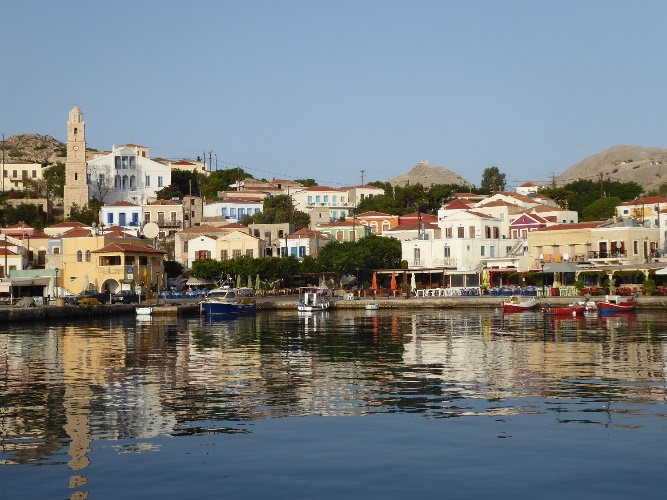 Khalki’s pretty little harbour was a mini Symi with its bright pastel coloured houses
spread around the harbour. It evidently has strong links with the USA - the stone built
clock tower was a gift from Greek emigrants to the USA and the road leading out of the
port and up towards the kastro is named Tarpon Springs Boulevard. It also has a church
with the tallest belfry in the Dodecanese and a throne on which is seated a giant
sponge!
Khalki’s pretty little harbour was a mini Symi with its bright pastel coloured houses
spread around the harbour. It evidently has strong links with the USA - the stone built
clock tower was a gift from Greek emigrants to the USA and the road leading out of the
port and up towards the kastro is named Tarpon Springs Boulevard. It also has a church
with the tallest belfry in the Dodecanese and a throne on which is seated a giant
sponge! 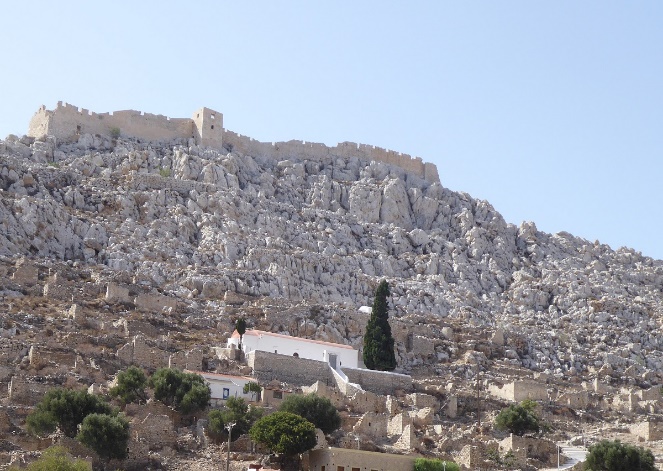 Another theme of our walks was the phenomenon of ruined villages. The towns and villages
of these islands – as in other areas of the Mediterranean – were built on high points
inland for protection against pirate attacks which were common for hundreds of years.
These villages – some medieval and some more recent - were gradually abandoned over time
as it became safe to live on the coast. A haunting atmosphere pervades their ruined
streets, homes and chapels. It is easy to imagine how difficult it would have been to
persuade the last aged inhabitant to move out after a lifetime in their village.
Another theme of our walks was the phenomenon of ruined villages. The towns and villages
of these islands – as in other areas of the Mediterranean – were built on high points
inland for protection against pirate attacks which were common for hundreds of years.
These villages – some medieval and some more recent - were gradually abandoned over time
as it became safe to live on the coast. A haunting atmosphere pervades their ruined
streets, homes and chapels. It is easy to imagine how difficult it would have been to
persuade the last aged inhabitant to move out after a lifetime in their village.
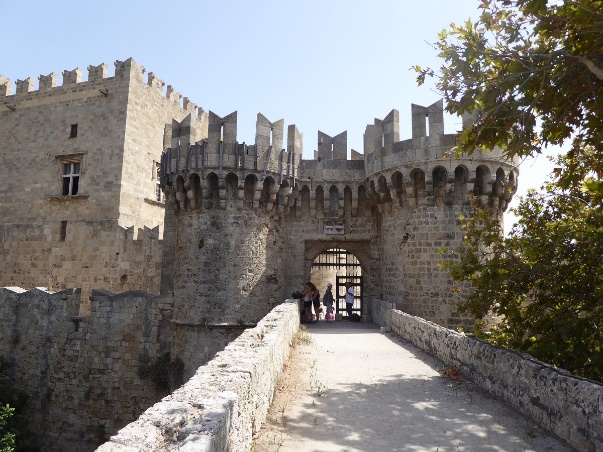 We left
Mark and Sarah in Rhodes, after a day together sightseeing the magnificent medieval town
with its mighty walls and imposing gates. It was interesting, having seen so many
crusader castles, finally to arrive at the hub of the Knights of St John. We visited the
Palace of the Grand Master, the interior rebuilt after its collapse during the Italian
occupation as a summer palace for Mussolini and the Italian king – a fascinating
grandiose 1930s take on medieval architecture. The large and perfect Roman mosaic floors
were stunning, albeit pilfered from Italian occupied Kos.
We left
Mark and Sarah in Rhodes, after a day together sightseeing the magnificent medieval town
with its mighty walls and imposing gates. It was interesting, having seen so many
crusader castles, finally to arrive at the hub of the Knights of St John. We visited the
Palace of the Grand Master, the interior rebuilt after its collapse during the Italian
occupation as a summer palace for Mussolini and the Italian king – a fascinating
grandiose 1930s take on medieval architecture. The large and perfect Roman mosaic floors
were stunning, albeit pilfered from Italian occupied Kos. 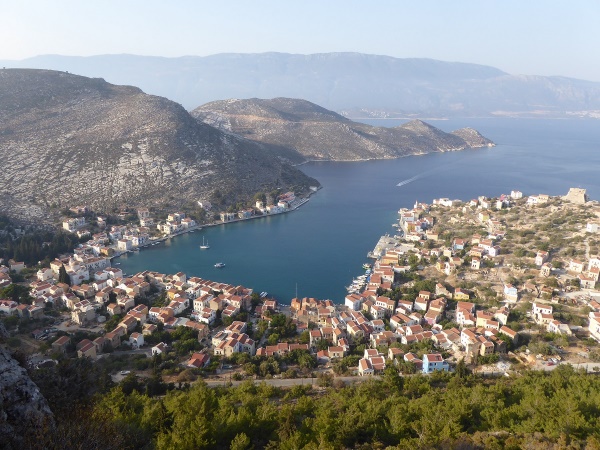 Our next destination was the tiny and furthest flung Greek island of Kastellorizo – 70
miles east of Rhodes its nearest Greek neighbour, and only one mile off the coast of
Turkey. The forecast downwind sleigh ride didn’t quite come up to expectations regarding
wind strength though we sailed nearly the whole way. By the end of the 14 hour passage
we were worn out by the tedious rolling of the boat and keen to get into a safe haven.
However, as so often happens as we approach Greek anchorages we faced a strong offshore
wind. This, together with the rock-strewn approach to the anchorage being straight into
the low evening sun did not make for a relaxing landfall. However, we dropped the anchor
between two rocky islets in failing light, hoping for the best, with a strong current
setting the boat disconcertingly at right angles to the wind.
Our next destination was the tiny and furthest flung Greek island of Kastellorizo – 70
miles east of Rhodes its nearest Greek neighbour, and only one mile off the coast of
Turkey. The forecast downwind sleigh ride didn’t quite come up to expectations regarding
wind strength though we sailed nearly the whole way. By the end of the 14 hour passage
we were worn out by the tedious rolling of the boat and keen to get into a safe haven.
However, as so often happens as we approach Greek anchorages we faced a strong offshore
wind. This, together with the rock-strewn approach to the anchorage being straight into
the low evening sun did not make for a relaxing landfall. However, we dropped the anchor
between two rocky islets in failing light, hoping for the best, with a strong current
setting the boat disconcertingly at right angles to the wind. 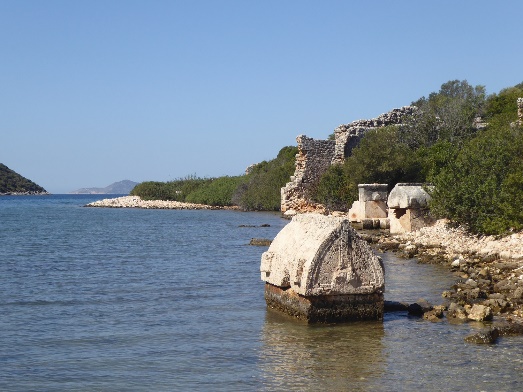
 After five days in Kastellorizo we made the final break from Greece and crossed the 4
miles over to the Turkish town of Kas before quickly moving on to our final cruising
location which turned out to be a superb finale. Backed by the Lycian Way – Kekova Roads
is a landlocked bay about 5 by 1-1 ½ miles across – protected from the sea by a
peninsular, the island of Kekova, islets and rocks. It is tranquil and scenic with
wooded hills, islands, spectacular rocks, and pretty coves.
Lycian sarcophagi are
scattered about in gay abandon, there’s a sunken Lycian town and a crusader castle. Two
rustic and ramshackle villages are protected from modern development, so remain in their
traditional picturesque state – save for the many trip boats and tourist stalls. We
spent a wonderful week in this delightful haven relishing the final days of this year’s
voyage – much enhanced by the company of Helen and John.
After five days in Kastellorizo we made the final break from Greece and crossed the 4
miles over to the Turkish town of Kas before quickly moving on to our final cruising
location which turned out to be a superb finale. Backed by the Lycian Way – Kekova Roads
is a landlocked bay about 5 by 1-1 ½ miles across – protected from the sea by a
peninsular, the island of Kekova, islets and rocks. It is tranquil and scenic with
wooded hills, islands, spectacular rocks, and pretty coves.
Lycian sarcophagi are
scattered about in gay abandon, there’s a sunken Lycian town and a crusader castle. Two
rustic and ramshackle villages are protected from modern development, so remain in their
traditional picturesque state – save for the many trip boats and tourist stalls. We
spent a wonderful week in this delightful haven relishing the final days of this year’s
voyage – much enhanced by the company of Helen and John.
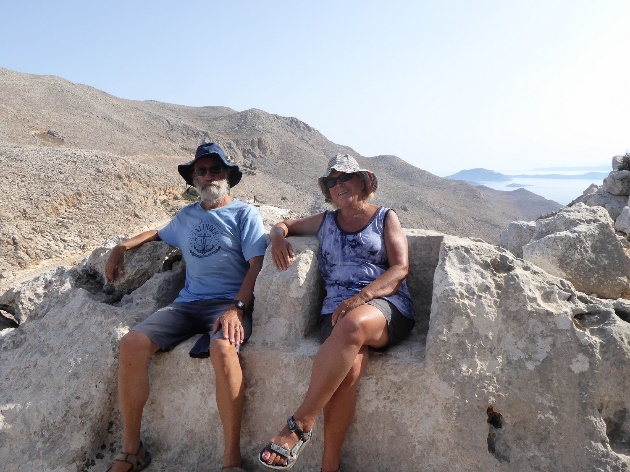 Skipper and FirstMate on the altar to Zeus and Hecate on Khalki.
Skipper and FirstMate on the altar to Zeus and Hecate on Khalki.